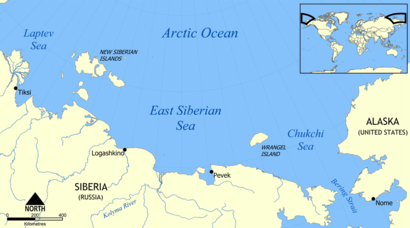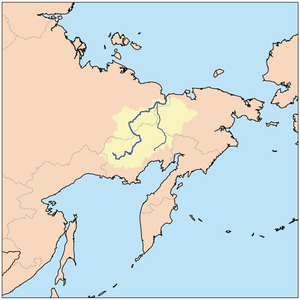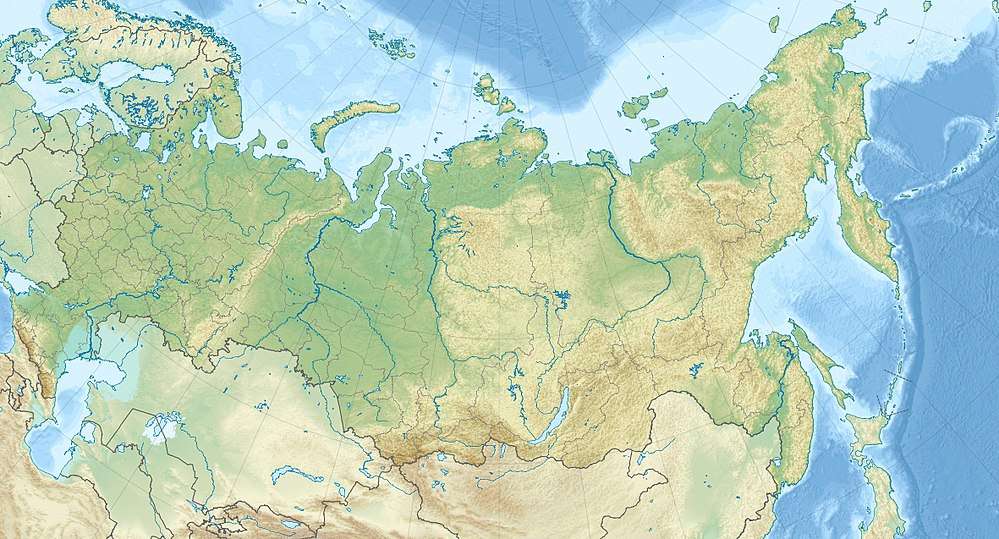Silene stenophylla
Silene stenophylla is a species of flowering plant in the family Caryophyllaceae. Commonly called narrow-leafed campion, it is a species in the genus Silene. It grows in the Arctic tundra of far eastern Siberia and the mountains of Northern Japan. Frozen samples, estimated via radiocarbon dating to be around 32,000 years old, were discovered in the same area as current living specimens, and in 2012 a team of scientists successfully regenerated a plant from the samples.[1][2]
| Silene stenophylla | |
|---|---|
 | |
| Scientific classification | |
| Kingdom: | Plantae |
| Clade: | Tracheophytes |
| Clade: | Angiosperms |
| Clade: | Eudicots |
| Order: | Caryophyllales |
| Family: | Caryophyllaceae |
| Genus: | Silene |
| Species: | S. stenophylla |
| Binomial name | |
| Silene stenophylla Ledeb. (1842) | |
Habitat and description

S. stenophylla grows in the Arctic tundra of far eastern Siberia and the mountains of Northern Japan.[3] It is typically 5–25 cm (2–10 in) tall, has narrow leaves, and a large calyx.[4] It blooms during the summer and has incised petals that are lilac, light pink, or white in color.[3] It is a perennial that grows on stony cliffs and sandy shores.[5] S. stenophylla is one of a few Beringian plant species that did not establish itself in North America.[6]
Etymology
The specific epithet is derived from the Greek stenos (narrow) and phyllon (leaf) to give “narrow-leaved”.[7]
Recovery of frozen remains
A team of scientists from Russia, Hungary and the United States recovered frozen Silene stenophylla seeds and remains from the Pleistocene in 2007, while investigating about 70 ancient ground squirrel (genus Urocitellus and Geomys ssp) hibernation burrows or caches, hidden in permanently frozen loess-ice deposits[1][2] located at Duvanny Yar, on the right bank of the lower Kolyma River in Sakha Republic, northeastern Siberia, in the plant's present-day range.[8]
Using radiocarbon dating, the age of the seeds was estimated at between 20,000 and 40,000 years, dating the seeds to the Pleistocene epoch.[8] The embryos were damaged, possibly by the animals' activity.[8] The research team presented their findings at the Botany & Plant Biology conference in Chicago, Illinois in 2007.[8] The burrows were found 20–40 meters (66–131 ft) below the present-day surface.[9] Usually the rodents would eat the food in their larders, but in this case a flood or other weather event buried the whole area. Since the rodents had placed the larders at the level of the permafrost, the material froze almost immediately, and did not thaw out at any time since.[9] More than 600,000 fruits and seeds were located at the site.[10]
Duvanny Yar
| Duvanny Yar | |
|---|---|
 Kolyma River | |
 | |
| Location | Russian Arctic, Sakha Republic |
| Coordinates | 68°38′0.28″N 159°4′43.68″E |
The Duvanny Yar section exposes the yedoma ice complex or suite and is studied by many scientists as it represents a key strategic cross-section of Late Quaternary East Siberian stratigraphy[2][11][12] and "an important key section for the palaeo-environmental history of the Late Pleistocene Beringia Land, the non-glaciated landmass between the Taymyr Peninsula and Alaska."[13] Near Duvanny Yar is the Pleistocene Park, (Russian: Плейстоценовый парк), a nature reserve on the Kolyma River south of Chersky where an attempt is being made to recreate the northern subarctic steppe grassland ecosystem that flourished in the area during the Last Glacial Period.[14]
Regeneration
In February 2012, a team of scientists from the Institute of Cell Biophysics of the Russian Academy of Sciences announced they had successfully regenerated specimens from fruit that had been frozen for 31,800 (±300) years according to radiocarbon dating.[9][15] The accomplishment surpasses the previous record for the oldest plant material brought back to life, of 2000 years set by Judean date palm seeds.[9] According to the BBC, the team led by David Gilichinsky used material recovered in 2007 by Stakhov et al.[9][10] Gilichinsky, who was head of the Geocryology Lab, Institute for Physicochemical and Biological Problems in Soil Science at the Russian Academy of Sciences, Moscow, for many years, died in February 2012, just before the paper was published. He was recognized by the team as a "pioneer in studying microorganisms in Siberian and Antarctic permafrost, his achievement attracted scientists from all over the world to research on permafrost life systems."[2]
Initially the researchers attempted to germinate mature seeds recovered from the fruit.[9] When these attempts failed, they turned to the fruit itself and were able to culture adult plants from placental tissue.[9] The team grew 36 specimens from the tissue.[10] The plants looked identical to modern specimens until they flowered, at which time the petals were observed to be longer and more widely spaced than modern versions of the plant.[10] Seeds produced by the regenerated plants germinated at a 100% success rate, compared with 90% for modern plants.[10] The reasons for the observed variations are not known.[9]
According to Robin Probert of the Millennium Seed Bank, the demonstration is "by far the most extraordinary example of extreme longevity for material from higher plants" to date.[9] It is not surprising to find living material this old, but is surprising that viable material could be recovered, she added. The Russian scientists speculated that the tissue cells were rich in sucrose which acted as a preservative.[9] They also noted that DNA damage caused by gamma radiation from natural ground radioactivity at the site was unusually low for the plant material's age and is comparable to levels observed in 1300-year-old lotus (Nelumbo nucifera) seeds proven to germinate.[10] Probert hopes that the techniques developed in the resurrection of Silene stenophylla may one day be used to resurrect extinct species.[9] Paleontologist Grant Zazula, who has previously disproven claims of ancient regeneration, said: "This discovery raises the bar incredibly in terms of our understanding in terms of the viability of ancient life in the permafrost."[16]
The successful regeneration of the Silene stenophylla plants was cited in 2014 as the inspiration for experiments that discovered a viable giant virus, Pithovirus sibericum, in 30,000-year-old Siberian permafrost; the virus infects amoebas.[17]
References
- Isachenkov, Vladimir (21 February 2012), "Russians revive Ice Age flower from frozen burrow", Jakarta Post via Associated Press, Moscow, archived from the original on 12 March 2016, retrieved 31 December 2014
- Yashinaa, Svetlana; Gubinb, Stanislav; Maksimovichb, Stanislav; Yashinaa, Alexandra; Gakhovaa, Edith; Gilichinsky, David (25 January 2012). Price, P. Buford (ed.). "Regeneration of whole fertile plants from 30,000-y-old fruit tissue buried in Siberian permafrost". Proceedings of the National Academy of Sciences of the United States of America. 109 (10): 4008–13. Bibcode:2012PNAS..109.4008Y. doi:10.1073/pnas.1118386109. PMC 3309767. PMID 22355102.
- Hideo Toyokuni (25 February 1979). "On some Noteworthy Plants from Hokkaidô, Japan" (PDF). Journal of the Faculty of Liberal Arts. 13: 127–133. ISSN 0583-0605. Archived from the original (PDF) on 7 April 2014. Retrieved 22 February 2012.
- Pavel Slabý. "Silene stenophylla Ledeb". Rock Garden Plants Database. Archived from the original on 25 February 2012. Retrieved 21 February 2012.
- S. G. Gorschkova (1970) [1936]. "Silene". In B. K. Schischkin (ed.). Flora of the U.S.S.R. ['Izdatel'stvo Akademii Nauk SSSR, Moskau-Leningrad)]. 6. Israel Program for Scientific Translations. p. 479.
- Ickert-Bond, Stefanie M.; Murray, David F.; DeChaine, Eric (2010). "Contrasting Patterns of Plant Distribution in Beringia" (PDF). Alaska Park Science. Arctic Alaska Park Service Symposium and Beringia International Conference. 8 (2): 26–32. Archived from the original (PDF) on 21 July 2010. Retrieved 21 February 2012.
- "Plantillustrations.org Epithet: stenophyllus,-a,-um". Retrieved 3 December 2018.
- Stakhov, V; Gyulai, Gabor; Szabó, Zoltan; Kovacs, Laszlo G.; Murenyetz, Lilja; Lagler, Richard; Toth, Zoltan; Yashina, S.; Bittsánszky, Andras; Heszky, Laszlo; Gubin, S. (8 July 2007). Pleistocene-age Silene stenophylla seeds excavated in Russia – a scanning electron microscopic analysis. Botany & Plant Biology 2007. Chicago, IL. Archived from the original on 25 February 2012.
- Richard Black. "Ancient plants back to life after 30,000 frozen years". BBC News. Retrieved 21 February 2012.
- Wade, Nicholas (20 February 2012). "Dead for 32,000 Years, an Arctic Plant Is Revived". New York Times. Retrieved 21 February 2012.
- Hopkins, D. M.; et al., eds. (1982), Paleoecology of Beringia, New York: Academic
- Strauss, Jens; Schirrmeister, Lutz; Wetterich, Sebastian; Borchers, Andreas; Davydov, Sergei P. (18 July 2012). "Grain-size properties and organic-carbon stock of Yedoma Ice Complex permafrost from the Kolyma lowland, northeastern Siberia" (PDF). Global Biogeochemical Cycles. 26 (3): GB3003. Bibcode:2012GBioC..26.3003S. doi:10.1029/2011gb004104.via Wiley
- Strauss, Jens; Wetterich, Sebastian; Schirrmeister, Lutz (June 2010), Permafrost properties of the Yedoma key site at Duvanny Yar (Kolyma lowland, East Siberia)
- "Pleistocene Park Underway: Home for Reborn Mammoths?", National Geographic, 17 May 2005, retrieved 20 April 2009,
During the last ice age northeastern Siberia remained a grassy refuge for scores of animals, including bison and woolly mammoths. Then, about 10,000 years ago, this vast ecosystem disappeared as the Ice Age ended. Now, though, the Ice Age landscape is on its way back, with a little help from the Russian scientists who have established "Pleistocene Park.
- "Scientists regenerate a plant – 30,000 years on". AFP. 20 February 2012. Archived from the original on 23 February 2012. Retrieved 21 February 2012.
- "Russian scientists germinate ice-age seed". CBC News. 20 February 2012. Retrieved 20 February 2012.
- Yong, Ed (3 March 2014). "Giant virus resurrected from 30,000-year-old ice : Nature News & Comment". Nature. doi:10.1038/nature.2014.14801.
External links
- Silene stenophylla picture from Jablonevij pass, Siberia
- Silene stenophylla regeneration experiment pictures
![]()